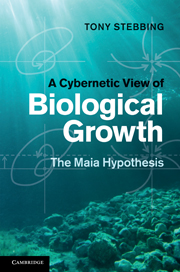Book contents
- Frontmatter
- Contents
- Foreword by Ernest Naylor
- Preface: ‘A fragment of a possible world’
- Acknowledgements
- 1 Introduction
- 2 Growth unlimited: blooms, swarms and plagues
- 3 Self-regulating systems: from machines to humans
- 4 The wealth of homeodynamic responses
- 5 A cybernetic approach to growth analysis
- 6 A control mechanism for Maia
- 7 The three levels of adaptation
- 8 Population growth and its control
- 9 Hierarchy: a controlled harmony
- 10 History of hormesis and links to homeopathy
- 11 Maian mechanisms for hormesis and catch-up growth
- 12 Cellular growth control and cancer
- 13 Human overpopulation
- 14 Our finite Earth
- 15 The Maia hypothesis and anagenesis
- Glossary
- Further reading
- References
- Index
3 - Self-regulating systems: from machines to humans
Published online by Cambridge University Press: 10 January 2011
- Frontmatter
- Contents
- Foreword by Ernest Naylor
- Preface: ‘A fragment of a possible world’
- Acknowledgements
- 1 Introduction
- 2 Growth unlimited: blooms, swarms and plagues
- 3 Self-regulating systems: from machines to humans
- 4 The wealth of homeodynamic responses
- 5 A cybernetic approach to growth analysis
- 6 A control mechanism for Maia
- 7 The three levels of adaptation
- 8 Population growth and its control
- 9 Hierarchy: a controlled harmony
- 10 History of hormesis and links to homeopathy
- 11 Maian mechanisms for hormesis and catch-up growth
- 12 Cellular growth control and cancer
- 13 Human overpopulation
- 14 Our finite Earth
- 15 The Maia hypothesis and anagenesis
- Glossary
- Further reading
- References
- Index
Summary
When, perhaps half a century ago, the fecundity of this concept [feedback] was seen, it was sheer euphoria to philosophize, epistemologize, and theorize about its consequences, its ramifications into various fields, and its unifying power.
Heinz von FoersterEARLY MAN-MADE CONTROL MECHANISMS
I was drawn towards the sight of a whitewashed stone windmill. It was high on the top of a conical hill in central Spain, its sails turning steadily in the breeze. The miller was pleased to show me around. The rotating sails, wooden gearing and turning millstones rumbled and creaked beneath the conical roof: a sound that cannot have changed for centuries. I knew that such windmills incorporated a primitive control mechanism to regulate the flow of corn, and I wanted to see it in operation. Suspended from the bottom of the hopper, a shallow sloping trough fed corn to a hole in the centre of the ‘running’ millstone. If the corn flows too fast the corn is incompletely ground; too slow and the flow of corn fails to keep the millstones apart, resulting in grit in the flour and millstones that soon need ‘dressing’. All this is prevented by a simple device which regulates the rate at which the corn flows. Attached to the hopper is a wooden ‘fiddle’ which rests on the rough-hewn surface of the ‘running’ millstone. As it turns, the fiddle dances over the surface, transmitting vibrations to the sloping trough.
- Type
- Chapter
- Information
- A Cybernetic View of Biological GrowthThe Maia Hypothesis, pp. 41 - 68Publisher: Cambridge University PressPrint publication year: 2010



